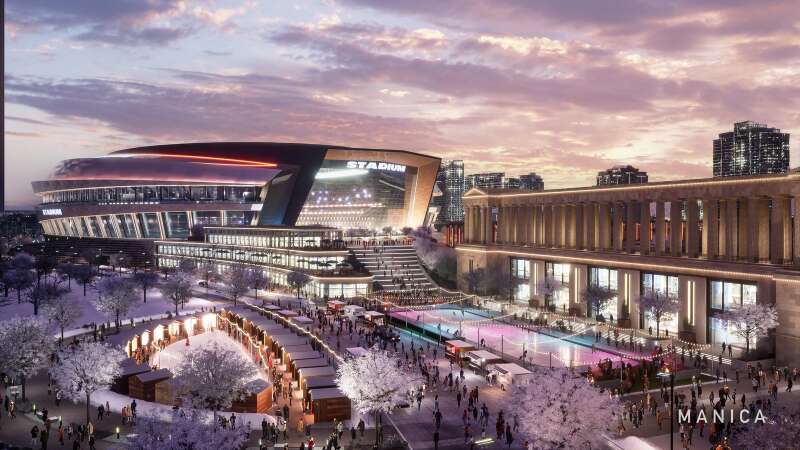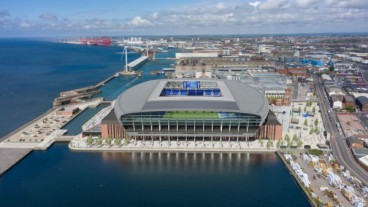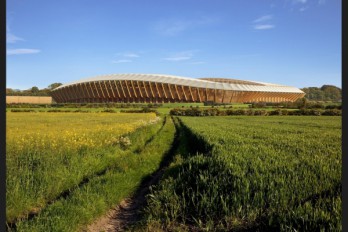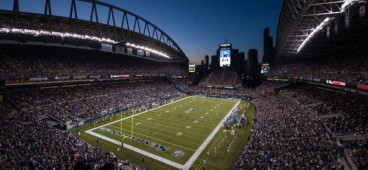Chicago Bears request $855 million public investment for New Arlington Heights stadium

The Chicago Bears have submitted a proposal seeking $855.2 million in public funding to support infrastructure for a new stadium in Arlington Heights, Illinois. The stadium itself, including the the surrounding mixed-use development, would reportedly be funded by the team, with total capital investment exceeding $5 billion when combined with ancillary development.
The stadium would be built on the site of the former Arlington Park racetrack, about 25 miles northwest of the Bears’ current home at Soldier Field. The team plans to break ground in 2026, contingent on state legislative approval of enabling legislation.
Designs released by the team show a fixed-roof, domed facility with a seating capacity in the range of 65,000 to 70,000. The plan also includes enhancements to local infrastructure intended to support the stadium and the broader development district such as public transit, road capacity, parking, and access routes.
An accompanying report, prepared by HR&A Advisors and released on October 1, projects that over 40 years the development could generate $2.28 billion in gross public revenues to state, local, and county jurisdictions (excluding property taxes).
The project site encompasses approximately 326 acres, identified by the Bears and consultants as one of the last large, transit-oriented land parcels available for large-scale redevelopment in the region. The mixed-use plan includes housing, retail, hotels, green space, and dining, all tied into the stadium footprint.
The Bears have not yet selected a general contractor. The stadium architect is Manica Architecture, while Hart Howerton is managing the master plan for the mixed-use district.
Implementation of the stadium hinges on passage of a so-called “mega project” bill currently under consideration in the Illinois legislature. This bill would allow projects in the $100 million to $500 million range (including this one) to negotiate property tax levels with municipalities rather than being locked into assessed-value rates.
Public officials have voiced concern over past financial obligations. In particular, the Bears still owe approximately $620 million associated with a prior renovation of Soldier Field in 2003, a debt some lawmakers see as a complicating factor in approving new public subsidies.
Supporters of the proposal argue that hosting a modern enclosed stadium would allow Arlington Heights to attract major events such as Super Bowls, national championships and concerts, and generate substantial economic activity. The report estimates a Super Bowl in Arlington Heights would produce over $230 million in economic impact and contribute $7.2 million in fiscal revenues for the City of Chicago.
Source: ABC7 Chicago
Want to read more like this story?

Cleveland Browns’ new stadium Huntington Bank Field plans include truss-free translucent roof
Oct, 03, 2025 | NewsA joint venture between AECOM Hunt and Turner Construction has been awarded the role of constructio...

Everton submits modified plans over its new stadium
Sep, 10, 2020 | NewsEverton, a football team playing in England's Premier League, has submitted modified plans for its n...

The Future of Stadium Engineering: Inside Manchester United’s Vision
Mar, 18, 2025 | NewsManchester United has set the stage for one of the most ambitious sports infrastructure projects in...

New York City FC unveils renderings of new stadium in Queens
May, 10, 2023 | NewsThe New York City Football Club revealed renderings of its new stadium in Queens, on May 10. The...

Timber football stadium project rejected
Jun, 20, 2019 | NewsThe project that included the construction of the first timber football stadium in the UK has been r...

Everton’s Modern Marvel: Redefining Stadium Construction at Bramley-Moore Dock
Jan, 23, 2025 | NewsEverton Football Club is gearing up for an exciting transformation with the construction of its sta...

One of the biggest dome structures in the US was demolished in a controlled implosion (video)
Nov, 23, 2017 | NewsOn Monday, November 20th, the Georgia Dome – an 80,000-capacity stadium that opened in 1992 and host...

Hawaii to spend $3.4 billion in infrastructure projects
May, 08, 2019 | NewsThe Hawaiian state will spend a $3.4 billion fund for the construction of new projects and the...

Seattle Seahawks Stadium Used for Earthquake Research
Jan, 15, 2015 | NewsThis Sunday the Seattle Seahawks will host the Green Bay Packers in the NFC Championship game. Many...
Trending

Vertical gardens in Mexico City to combat pollution

Characteristics of Load Bearing Masonry Construction

Taipei 101’s impressive tuned mass damper

Morocco Implements Landmark Dam Perforation to Combat Water Stress in Marrakech

Dutch greenhouses have revolutionized modern farming



